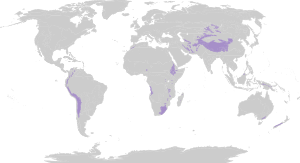Montane grasslands and shrublands facts for kids
Montane grasslands and shrublands are special places on Earth. They are a type of biome, which is a large area with similar plants, animals, and climate. These biomes are found high up in mountains around the world. The word "montane" means "high altitude" or "mountainous," so these are grasslands and shrublands that grow in cool, high places.
Contents
What Are Montane Grasslands and Shrublands?
This biome includes high-up areas like mountain and alpine grasslands and shrublands. You can find them in many parts of the world. For example, there are the puna and páramo in South America. You can also find subalpine heath in New Guinea and East Africa. The vast steppes of the Tibetan Plateau are another example. These areas are all found at high elevations, often just below where trees can no longer grow.
Amazing Plants and Animals
The plants and animals living in tropical montane páramos are very special. They have learned to survive in cool, wet places with strong sunlight. Many plants in these habitats have unique features. Some have a rosette shape, which means their leaves grow in a circular pattern close to the ground. Others have waxy surfaces or lots of tiny hairs. These features help them deal with the cold and strong sun.
Where Are They Found?
The páramos in the northern Andes mountains are the biggest examples of this habitat. Even though these ecosystems are most diverse in the Andes, they are unique wherever they appear in warm, tropical areas. Places like the heathlands of East Africa, such as Mount Kilimanjaro, Mount Kenya, and the Rwenzori Mountains, are also home to these special plants and animals. You can also find them on Mount Kinabalu in Borneo and the Central Range of New Guinea. These areas are often small and isolated, meaning they have plants and animals found nowhere else.
Drier Mountain Grasslands
Not all montane grasslands are wet. Some drier ones are found in subtropical areas. These include the Ethiopian Highlands and the Zambezian montane grasslands in Africa. The montane habitats in southeastern Africa are also part of this group. These areas might have more savannas and woodlands mixed with the grasslands.
Unique Wildlife and Giant Plants
The montane grasslands of the Tibetan Plateau are still home to amazing animal migrations. You can see Tibetan antelope (Pantholops hodgsoni) and kiang, also known as Tibetan wild ass (Equus hemionus), moving across these lands.
A really cool thing about many tropical páramos is the presence of giant rosette plants. These plants come from different plant families but share a similar giant rosette shape. Examples include Lobelia in Africa, Puya in South America, Cyathea in New Guinea, and Argyroxiphium in Hawai’i. These impressive plants can grow at very high elevations, sometimes up to 4,500 to 4,600 meters (about 14,760 to 15,090 feet) above sea level!
Images for kids
See also
 In Spanish: Praderas y matorrales de montaña para niños
In Spanish: Praderas y matorrales de montaña para niños



